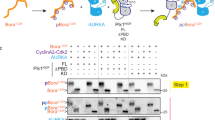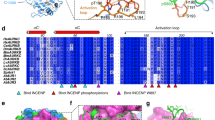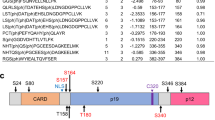Abstract
Mammalian Aurora-A is related to a serine/threonine protein kinase that was originally identified by its close homology with Saccharomyces cerevisiae Ipl1p and Drosophila melanogaster aurora that are key regulators in the orchestration of mitotic events. The protein level of Aurora-A, its peak kinase activity during mitosis, and its activation have been attributed to phosphorylation. Here we show that this enzyme is an arginine-directed kinase and define its substrate specificity. We also found that Thr288 within the activation loop is a critical residue for activating phosphorylation events in vitro and that it is spatiotemporally restricted to a brief window at mitosis on duplicated centrosomes and on spindle microtubules proximal to the poles in vivo. Immunodepletion assays indicated that an upstream kinase(s) of Aurora-A might exist in mammalian cells in addition to autophosphorylation. Furthermore, human activated Aurora-A forms complexes with the negative regulator protein serine/threonine phosphatase type 1 (PP1) that was negatively phosphorylated on Thr320. Interestingly, phospho-specific Aurora-A monoclonal antibodies restrain Aurora-A kinase activity in vitro, providing further therapeutic avenues to explore.
This is a preview of subscription content, access via your institution
Access options
Subscribe to this journal
Receive 50 print issues and online access
$259.00 per year
only $5.18 per issue
Buy this article
- Purchase on Springer Link
- Instant access to full article PDF
Prices may be subject to local taxes which are calculated during checkout






Similar content being viewed by others
Accession codes
References
Adams RR, Carmena M, Earnshaw WC . (2001). Trends Cell Biol 11: 49–54.
Andrews PD, Knatko E, Moore WJ, Swedlow JR . (2003). Curr Opin Cell Biol 15: 672–683.
Ban R, Irino Y, Fukami K, Tanaka H . (2004). J Biol Chem 279: 16394–16402.
Bayliss R, Sardon T, Vernos I, Conti E . (2003). Mol Cell 12: 851–862.
Bischoff JR, Anderson L, Zhu Y, Mossie K, Ng L, Souza B et al. (1998). EMBO J 17: 3052–3065.
Carmena M, Earnshaw WC . (2003). Nat Rev Mol Cell Biol 4: 842–854.
Castro A, Arlot-Bonnemains Y, Vigneron S, Labbe JC, Prigent C, Lorca T . (2002). EMBO Rep 3: 457–462.
Chan CS, Botstein D . (1993). Genetics 135: 677–691.
Cheeseman IM, Anderson S, Jwa M, Green EM, Kang J, Yates JR et al. (2002). Cell 111: 163–172.
Cheetham GM, Knegtel RM, Coll JT, Renwick SB, Swenson L, Weber P et al. (2002). J Biol Chem 277: 42419–42422.
Ditchfield C, Johnson VL, Tighe A, Ellston R, Haworth C, Johnson T et al. (2003). J Cell Biol 161: 267–280.
Dohadwala M, da Cruz e Silva EF, Hall FL, Williams RT, Carbonaro-Hall DA, Nairn AC et al. (1994). Proc Natl Acad Sci USA 91: 6408–6412.
Du J, Hannon GJ . (2004). Proc Natl Acad Sci USA 101: 8975–8980.
Duclos B, Marcandier S, Cozzone AJ . (1991). Methods Enzymol 201: 10–21.
Dutertre S, Cazales M, Quaranta M, Froment C, Trabut V, Dozier C et al. (2004). J Cell Sci 117: 2523–2531.
Ewart-Toland A, Briassouli P, de Koning JP, Mao JH, Yuan J, Chan F et al. (2003). Nat Genet 34: 403–412.
Ewart-Toland A, Dai Q, Gao YT, Nagase H, Dunlop MG, Farrington SM et al. (2005). Carcinogenesis 26: 1368–1373.
Eyers PA, Erikson E, Chen LG, Maller JL . (2003). Curr Biol 13: 691–697.
Eyers PA, Maller JL . (2004). J Biol Chem 279: 9008–9015.
Ferrari S, Marin O, Pagano MA, Meggio F, Hess D, El-Shemerly M et al. (2005). Biochem J 390: 293–302.
Gassmann R, Carvalho A, Henzing AJ, Ruchaud S, Hudson DF, Honda R et al. (2004). J Cell Biol 166: 179–191.
Giet R, Petretti C, Prigent C . (2005). Trends Cell Biol 15: 241–250.
Glover DM, Leibowitz MH, McLean DA, Parry H . (1995). Cell 81: 95–105.
Goto H, Yasui Y, Kawajiri A, Nigg EA, Terada Y, Tatsuka M et al. (2003). J Biol Chem 278: 8526–8530.
Goto H, Yasui Y, Nigg EA, Inagaki M . (2002). Genes Cells 7: 11–17.
Harrington EA, Bebbington D, Moore J, Rasmussen RK, Ajose-Adeogun AO, Nakayama T et al. (2004). Nat Med 10: 262–267.
Hauf S, Cole RW, LaTerra S, Zimmer C, Schnapp G, Walter R et al. (2003). J Cell Biol 161: 281–294.
Haydon CE, Eyers PA, Aveline-Wolf LD, Resing KA, Maller JL, Ahn NG . (2003). Mol Cell Proteomics 2: 1055–1067.
Helps HR, Luo X, Barker HM, Cohen PT . (2000). Biochem J 349: 509–518.
Hirota T, Kunitoku N, Sasayama T, Marumoto T, Zhang D, Nitta M et al. (2003). Cell 114: 585–598.
Honda K, Mihara H, Kato Y, Yamaguchi A, Tanaka H, Yasuda H et al. (2000). Oncogene 19: 2812–2819.
Honda R, Korner R, Nigg EA . (2003). Mol Biol Cell 14: 3325–3341.
Johnson LN, Noble ME, Owen DJ . (1996). Cell 85: 149–158.
Katayama H, Sasai K, Kawai H, Yuan ZM, Bondaruk J, Suzuki F et al. (2004). Nat Genet 36: 55–62.
Katayama H, Zhou H, Li Q, Tatsuka M, Sen S . (2001). J Biol Chem 276: 46219–46224.
Kawajiri A, Yasui Y, Goto H, Tatsuka M, Takahashi M, Nagata K et al. (2003). Mol Biol Cell 14: 1489–1500.
Keen N, Taylor S . (2004). Nat Rev Cancer 4: 927–936.
Kennelly PJ . (2002). FEMS Microbiol Lett 206: 1–8.
Knighton DR, Zheng JH, Ten Eyck LF, Xuong NH, Taylor SS, Sowadski JM . (1991). Science 253: 414–420.
Kufer TA, Sillje HH, Korner R, Gruss OJ, Meraldi P, Nigg EA . (2002). J Cell Biol 158: 617–623.
Kunitoku N, Sasayama T, Marumoto T, Zhang D, Honda S, Kobayashi O et al. (2003). Dev Cell 5: 853–864.
Kwon YG, Lee SY, Choi Y, Greengard P, Nairn AC . (1997). Proc Natl Acad Sci USA 94: 2168–2173.
Li X, Sakashita G, Matsuzaki H, Sugimoto K, Kimura K, Hanaoka F et al. (2004). J Biol Chem 279: 47201–47211.
Littlepage LE, Wu H, Andresson T, Deanehan JK, Amundadottir LT, Ruderman JV . (2002). Proc Natl Acad Sci USA 99: 15440–15445.
Liu Q, Kaneko S, Yang L, Feldman RI, Nicosia SV, Chen J et al. (2004). J Biol Chem 279: 52175–52182.
Marumoto T, Honda S, Hara T, Nitta M, Hirota T, Kohmura E et al. (2003). J Biol Chem 278: 51786–51795.
Marumoto T, Zhang D, Saya H . (2005). Nat Rev Cancer 5: 42–50.
Meraldi P, Honda R, Nigg EA . (2004). Curr Opin Genet Dev 14: 29–36.
Minoshima Y, Kawashima T, Hirose K, Tonozuka Y, Kawajiri A, Bao YC et al. (2003). Dev Cell 4: 549–560.
Murata-Hori M, Fumoto K, Fukuta Y, Iwasaki T, Kikuchi A, Tatsuka M et al. (2000). J Biochem (Tokyo) 128: 903–907.
Newton AC . (2003). Biochem J 370: 361–371.
Nigg EA . (2001). Nat Rev Mol Cell Biol 2: 21–32.
Nolen B, Taylor S, Ghosh G . (2004). Mol Cell 15: 661–675.
Nowakowski J, Cronin CN, McRee DE, Knuth MW, Nelson CG, Pavletich NP et al. (2002). Structure 10: 1659–1667.
Ohi R, Sapra T, Howard J, Mitchison TJ . (2004). Mol Biol Cell 15: 2895–2906.
Ouchi M, Fujiuchi N, Sasai K, Katayama H, Minamishima YA, Ongusaha PP et al. (2004). J Biol Chem 279: 19643–19648.
Pugacheva EN, Golemis EA . (2005). Nat Cell Biol 7: 937–946.
Puntoni F, Villa-Moruzzi E . (1997). Mol Cell Biochem 171: 115–120.
Reed SI . (2003). Nat Rev Mol Cell Biol 4: 855–864.
Sakai H, Urano T, Ookata K, Kim MH, Hirai Y, Saito M et al. (2002). J Biol Chem 277: 48714–48723.
Sausville EA . (2004). Nat Med 10: 234–235.
Sessa F, Mapelli M, Ciferri C, Tarricone C, Areces LB, Schneider TR et al. (2005). Mol Cell 18: 379–391.
Shima H, Hatano Y, Chun YS, Sugimura T, Zhang Z, Lee EY et al. (1993). Biochem Biophys Res Commun 192: 1289–1296.
Sugiyama K, Sugiura K, Hara T, Sugimoto K, Shima H, Honda K et al. (2002). Oncogene 21: 3103–3111.
Taguchi S, Honda K, Sugiura K, Yamaguchi A, Furukawa K, Urano T . (2002). FEBS Lett 519: 59–65.
Tanaka M, Ueda A, Kanamori H, Ideguchi H, Yang J, Kitajima S et al. (2002). J Biol Chem 277: 10719–10726.
Toji S, Yabuta N, Hosomi T, Nishihara S, Kobayashi T, Suzuki S et al. (2004). Genes Cells 9: 383–397.
Tsai MY, Wiese C, Cao K, Martin O, Donovan P, Ruderman J et al. (2003). Nat Cell Biol 5: 242–248.
Urano T, Emkey R, Feig LA . (1996). EMBO J 15: 810–816.
Walter AO, Seghezzi W, Korver W, Sheung J, Lees E . (2000). Oncogene 19: 4906–4916.
Wheatley SP, Henzing AJ, Dodson H, Khaled W, Earnshaw WC . (2004). J Biol Chem 279: 5655–5660.
Wu JC, Chen TY, Yu CT, Tsai SJ, Hsu JM, Tang MJ et al. (2005). J Biol Chem 280: 9013–9022.
Xu ZB, Chaudhary D, Olland S, Wolfrom S, Czerwinski R, Malakian K et al. (2004). J Biol Chem 279: 50401–50409.
Yamano H, Ishii K, Yanagida M . (1994). EMBO J 13: 5310–5318.
Yasui Y, Urano T, Kawajiri A, Nagata K, Tatsuka M, Saya H et al. (2004). J Biol Chem 279: 12997–13003.
Yu CT, Hsu JM, Lee YC, Tsou AP, Chou CK, Huang CY . (2005). Mol Cell Biol 25: 5789–5800.
Zeitlin SG, Shelby RD, Sullivan KF . (2001). J Cell Biol 155: 1147–1157.
Zhao ZS, Lim JP, Ng YW, Lim L, Manser E . (2005). Mol Cell 20: 237–249.
Zhou H, Kuang J, Zhong L, Kuo WL, Gray JW, Sahin A et al. (1998). Nat Genet 20: 189–193.
Acknowledgements
The first two authors equally contributed to this work. This work is dedicated to our late co-author and friend Mizuho Nagasawa, who passed away on April 7, 2005. We thank Larry A Feig (Tufts University, Boston) for critical reading of the manuscript, valuable suggestions, and for the anti-glu and anti-myc monoclonal antibodies, and Angus C Nairn (The Rockefeller University, New York) for anti-phospho-specific PP1α (pThr-320) polyclonal antibody. This study was supported by a grant-in-aid for Scientific Research and the 21st Century COE Program from the Ministry of Education, Culture, Sports, Science and Technology of Japan. SO and RB were supported by the Japanese Society for the Promotion of Science Research Fellowships for Young Scientists.
Author information
Authors and Affiliations
Corresponding author
Additional information
Supplementary Information accompanies the paper on Oncogene website (http://www.nature.com/onc)
Rights and permissions
About this article
Cite this article
Ohashi, S., Sakashita, G., Ban, R. et al. Phospho-regulation of human protein kinase Aurora-A: analysis using anti-phospho-Thr288 monoclonal antibodies. Oncogene 25, 7691–7702 (2006). https://doi.org/10.1038/sj.onc.1209754
Received:
Revised:
Accepted:
Published:
Issue Date:
DOI: https://doi.org/10.1038/sj.onc.1209754
Keywords
This article is cited by
-
Therapeutic Effectiveness of Anticancer Agents Targeting Different Signaling Molecules Involved in Asymmetric Division of Cancer Stem Cell
Stem Cell Reviews and Reports (2023)
-
Design, synthesis, and evaluation of 4-chromenone derivatives combined with N-acylhydrazone for aurora kinase A inhibitor
Applied Biological Chemistry (2021)
-
Adhesion-growth factor crosstalk regulates AURKB activation and ERK signalling in re-adherent fibroblasts
Journal of Biosciences (2021)
-
A novel interaction between kinase activities in regulation of cilia formation
BMC Cell Biology (2017)
-
Systematic computation with functional gene-sets among leukemic and hematopoietic stem cells reveals a favorable prognostic signature for acute myeloid leukemia
BMC Bioinformatics (2015)



